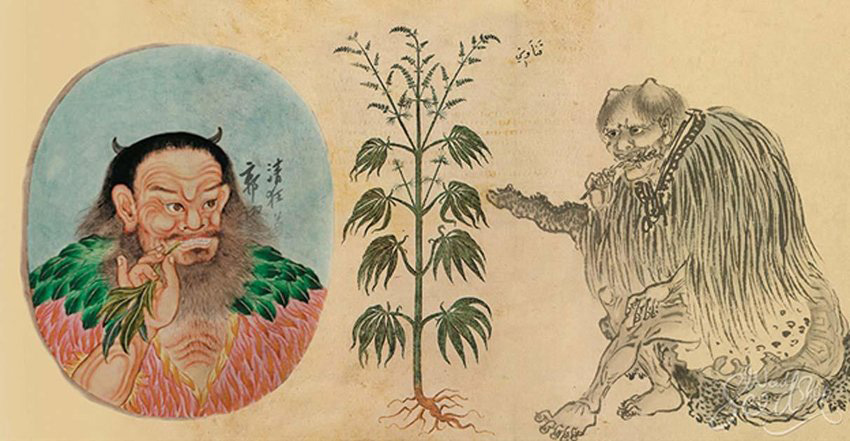Cannabis History
6000 BC
In China, cannabis seeds are used for food.
6000 BC
4000 BC
Chinese farmers cultivate the plant for its fiber to make clothing and rope.
4000 BC

2727 BC
First known use of cannabis being used as a medicine.
2727 BC
1500 BC
In Egypt, the Ebers papyrus mentions using cannabis topically for inflammation.
1500 BC
70 AD
Greek physician Dioscorides writes that boiled cannabis roots are used to alleviate inflammation.
70 AD
170 AD
Roman and Greek physician Claudius Galen writes about dessert cakes containing cannabis seeds served in Italy and their psychoactive effects.
170 AD
1150 AD
The use of hashish becomes popular in the Middle East.
1150 AD
1545 AD
Spaniards bring cannabis to Chile for making products with its fiber.
1545 AD
1753 AD
Swedish botanist and physician Carolus Linnaeus, known for created a system for naming and organizing species, classifies the plant as Cannabis Sativa Linnaeus (L.) in his well-known botanical taxonomy. Linnaeus states that the genus Cannabis sativa contains one species of plant.
1753 AD
1785 AD
Biologist Jean-Baptiste de Lamarck classifies a plant that he discovered in India as a separate species, Cannabis indica.
1785 AD
1798 AD
Napoleon's soldiers are introduced to hashish during the Egyptian campaign and bring cannabis back with them to France.
1798 AD
1839 AD
Dr. William B. O'Shaughnessy publishes his research findings on the medicinal uses of cannabis, highlighting the plant's efficacy as an anti-convulsant and muscle relaxant.
1839 AD
1840 AD
Persian pharmacies in American start selling medicinal products containing cannabis.
1840 AD

1887 AD
German botanist Walther Otto Müller’s drawing of Cannabis sativa L. is published in the Franz Eugen Köhler’s book Medizinal-Pflanzen.
1887 AD
1890 AD
British physician J. Russel Reynolds, appointed physician-in-ordinary to Queen Victoria’s household, publishes his 30 years of acquired knowledge about the plant and the challenge of its pharmacological use due to inconsistencies in potency.
1890 AD
1930 AD
The Federal Bureau of Narcotics is formed.
1930 AD

1936 AD
The film Reefer Madness is released. Considered one of the worst films ever made, Reefer Madness is an exploitation film about the dangers of cannabis and was originally intended to serve as a morality tale. The film has acquired a cult following for its satirical, misinformed views and blatant anti-cannabis propaganda.
1936 AD
1937 AD
The Marihuana Tax Act passes. Federal Bureau of Narcotics Commissioner Harry Anslinger leads the campaign against cannabis, resulting in the passage of the Marihuana Tax Act. While other countries had already banned the plant, the U.S. government held back on a ban because of the plant's industrial uses, namely seed, oil, and plant fibers, and also due to cannabis research into therapeutic uses of the plant. The act halts the recreational use of cannabis. It fractures the economics of the U.S. hemp industry and virtually eliminates cannabis testing and scientific study.
1937 AD
1964 AD
The cannabis psychoactive cannabinoid tetrahydrocannabinol (THC) is identified as the intoxicating component in cannabis.
1964 AD
1970 AD
The U.S. categorizes cannabis as a Schedule I drug. A drug that is considered not to have a medical use and has a high potential for abuse.
1970 AD

1971 AD
During a press conference President Richard Nixon declares drug abuse “public enemy number one.” The term “War on Drugs” is coined by the media.
1971 AD

1980 AD
Paul McCartney is arrested in Tokyo, Japan for possessing 8 ounces of cannabis and spends 9 days in jail.
1980 AD
1992 AD
The human body's endocannabinoid system (ECS) is discovered, and scientists learn how plant cannabinoids work with the ECS. The ECS regulates systems in the human body, including immune response, inflammation, memory, pain control, and sleep.
1992 AD
1992 AD
Presidential candidate Bill Clinton says in a CBS interview, “When I was in England I experimented with marijuana a time or two, and I didn't like it. I didn't inhale.”
1992 AD
1996 AD
California becomes the first state to legalize cannabis for medical purposes.
1996 AD
2012 AD
Colorado and Washington become the first states to legalize cannabis for recreational purposes.
2012 AD
2014 AD
The Rohrabacher-Farr amendment passes. The amendment prevents people complying with state medical cannabis laws from federal prosecution.
2014 AD

2019 AD
A team of archaeologists at the Chinese Academy of Sciences discovers physical evidence that people 2,500 years ago burned cannabis to get high during funeral proceedings and mourning.
2019 AD
2024 AD
The U.S. Department of Justice (DOJ) proposes to reschedule cannabis from Schedule I to Schedule III. Schedule III drugs have a lower risk of dependence, and the rescheduling could bolster positive perceptions of cannabis’ medical and therapeutic benefits.
2024 AD
Present Day
Today, cannabis is consumed recreationally by more than 150 million people regularly, and science continues to discover compounds and therapeutic uses for the plant that were previously unknown.
In the United States, medical use of cannabis is legal in 38 states, four U.S. territories, and the District of Columbia (D.C.). Recreational use of cannabis is legal in 24 states, three U.S. territories, and D.C. (2024)
